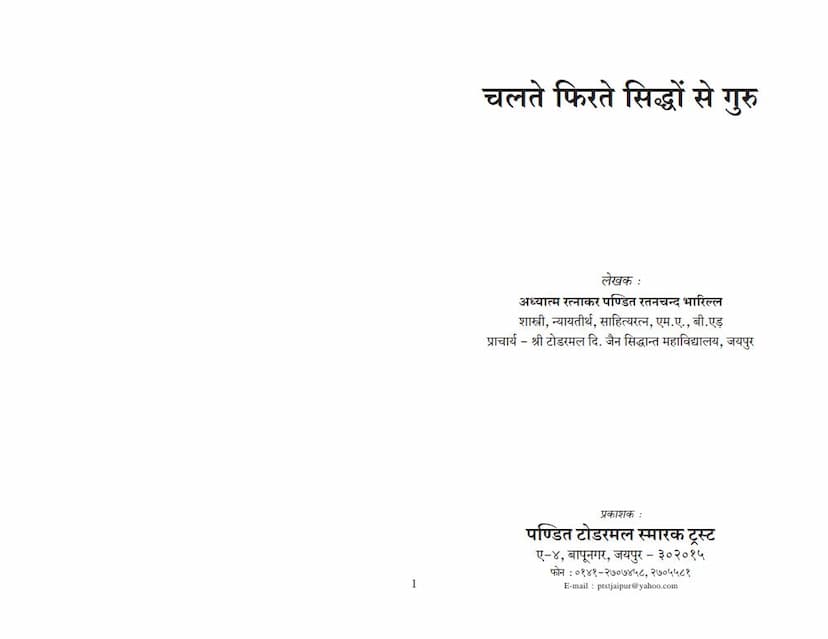Chalte Phirte Siddho Se Guru
Added to library: September 1, 2025

Summary
This book, "Chalte Phirte Siddho se Guru" (Guru from Moving Siddhas) by Ratan Chand Bharilla, published by Todarmal Granthamala Jaipur, is a comprehensive exploration of the life, conduct, and philosophical underpinnings of Digambar Jain monks. The author, an acclaimed scholar and principal, meticulously weaves complex Jain doctrines into an accessible narrative, primarily through a question-and-answer format based on discourses.
The book is structured to guide readers through the profound principles of Jainism, particularly focusing on the path to liberation as exemplified by the monks. It aims to remove misconceptions and foster a genuine understanding and reverence for the monastic life.
Key themes and content covered in the book include:
- The Nature and Significance of Monasticism: The book emphasizes that true liberation cannot be attained without embracing the monastic path. It highlights the immense spiritual bliss derived from a life of renunciation, which, despite appearing austere, offers unparalleled inner joy.
- The Ideal Digambar Monk: A detailed portrait of the Digambar monk is presented, emphasizing their detachment from sensory pleasures, their deep absorption in spiritual knowledge and meditation, their complete renunciation of possessions, their nudity as a natural state of being free from inner turmoil, and their fearless, self-reliant existence akin to a lion.
- The 28 Fundamental Vows (Moolgunas): The book elaborates on the 28 fundamental vows observed by monks, including the five great vows (Mahavratas), five restraints (Samitis), five senses control, six essential duties (Shad Aavashyak), and seven additional vows like celibacy, nakedness, living on the ground, self-plucking of hair, taking food standing, and eating once a day. Each vow is explained with its underlying principles and significance.
- The 13 Types of Conduct (Charitra): The text delves into the thirteen categories of conduct that govern a monk's life, encompassing the 28 Moolgunas, three Guptis (control of mind, speech, and body), and other virtues.
- The 12 Reflections (Bhavanas): A significant portion of the book is dedicated to the twelve reflections, which are crucial for cultivating detachment and spiritual progress. These reflections, such as impermanence, helplessness, the cycle of existence, solitude, separateness, impurity, influx of karma, cessation of influx, elimination of karma, the nature of the universe, the rarity of enlightenment, and the nature of Dharma, are explained in detail.
- The 22 Categories of Voluntary Hardships (Parishaha): The book meticulously details the 22 types of hardships that monks voluntarily endure and overcome with equanimity as a means of spiritual purification and karma eradication. These include hunger, thirst, cold, heat, insect bites, nudity, non-compliance, rejection, begging, loss, illness, bodily discomfort, being struck, begging for alms, not getting alms, disease, pain from grass/thorns, filth, disrespect, ignorance, lack of knowledge, and lack of insight.
- The 12 Types of Austerities (Tapas): The text discusses the internal and external austerities undertaken by monks to burn away karmas and achieve liberation. These include six external austerities (fasting, reduced intake, limited begging, taste renunciation, solitary dwelling, and physical hardship) and six internal austerities (penance, humility, service, study, detachment, and meditation).
- The Five Conducts (Panchacharya): The book explains the five cardinal conducts of monastic life: Darshanacharya (conduct related to right faith), Jnanacharya (conduct related to right knowledge), Charitreacharya (conduct related to right conduct), Tapacharya (conduct related to austerity), and Viryacharya (conduct related to spiritual energy).
- The Importance of Non-Attachment and Detachment: A recurring theme is the necessity of detachment from worldly possessions, sensory pleasures, and even the body itself, as a prerequisite for spiritual advancement.
- Dispelling Misconceptions: The book addresses common misunderstandings about monastic life, particularly regarding nudity, explaining it as a natural state of inner purity and freedom from shame, not as immodesty. It also clarifies the concept of 'uddhisht' (designated) food, emphasizing that monks do not accept specially prepared food but accept whatever pure food is offered without solicitation.
- The Interplay of Nayas (Standpoints): The author skillfully explains the significance of Naya (standpoints) in Jain philosophy, illustrating how both the ultimate truth (Nischaya Naya) and the practical, conventional truth (Vyavahar Naya) are essential for a complete understanding of Dharma and the path to liberation.
- The Role of Dev, Guru, and Dharma: The book underscores the importance of understanding the true nature of the Divine, the enlightened guides (Gurus), and the path of righteousness (Dharma) as foundational for right faith and spiritual progress.
- The Significance of Human Birth: The rarity and preciousness of human birth are emphasized, highlighting it as the opportune moment for spiritual endeavor and the pursuit of liberation.
"Chalte Phirte Siddho se Guru" is presented as a guide for individuals contemplating the monastic path, those who wish to understand it better, and indeed anyone seeking a deeper connection with Jain principles. It aims to inspire reverence and devotion towards the monks, whom it describes as "moving Siddhas" – beings who have attained or are on the path to complete liberation while still in human form. The book is praised for its clarity, depth, and the author's ability to convey profound spiritual truths in an engaging and accessible manner.